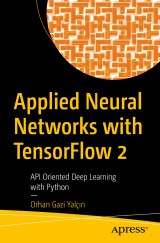Details

Applied Neural Networks with TensorFlow 2
API Oriented Deep Learning with Python|
CHF 65.00 |
|
| Verlag: | Apress |
| Format: | |
| Veröffentl.: | 29.11.2020 |
| ISBN/EAN: | 9781484265130 |
| Sprache: | englisch |
Dieses eBook enthält ein Wasserzeichen.
Beschreibungen
Implement deep learning applications using TensorFlow while learning the “why” through in-depth conceptual explanations. <div><br></div><div>You’ll start by learning what deep learning offers over other machine learning models. Then familiarize yourself with several technologies used to create deep learning models. While some of these technologies are complementary, such as Pandas, Scikit-Learn, and Numpy—others are competitors, such as PyTorch, Caffe, and Theano. This book clarifies the positions of deep learning and Tensorflow among their peers. </div><div><br></div><div>You'll then work on supervised deep learning models to gain applied experience with the technology. A single-layer of multiple perceptrons will be used to build a shallow neural network before turning it into a deep neural network. After showing the structure of the ANNs, a real-life application will be created with Tensorflow 2.0 Keras API. Next, you’ll work on data augmentation and batch normalization methods. Then, the Fashion MNIST dataset will be used to train a CNN. CIFAR10 and Imagenet pre-trained models will be loaded to create already advanced CNNs.</div><div><div><br></div> <div>Finally, move into theoretical applications and unsupervised learning with auto-encoders and reinforcement learning with tf-agent models. With this book, you’ll delve into applied deep learning practical functions and build a wealth of knowledge about how to use TensorFlow effectively.</div><div><br></div> <div><b>What You'll Learn</b></div> <div><ul><li>Compare competing technologies and see why TensorFlow is more popular<br></li><li>Generate text, image, or sound with GANs<br></li><li>Predict the rating or preference a user will give to an item<br></li><li>Sequence data with recurrent neural networks</li></ul></div> <div><b>Who This Book Is For</b></div><div><b><br></b></div> Data scientists and programmers new to the fields of deep learning and machine learning APIs. </div>
Chapter 1: Introduction.- Chapter 2: Introduction to Machine Learning.- Chapter 3: Deep Learning and Neutral Networks Overview.- Chapter 4: Complimentary Libraries to TensorFlow 2.x.- Chapter 5: A Guide to TensorFlow 2.0 and Deep Learning Pipeline.- Chapter 6: Feedfoward Neutral Networks.- Chapter 7: Convolutional Neural Networks.- Chapter 8: Recurrent Neural Networks.- Chapter 9: Natural Language Processing.- Chapter 10: Recommender Systems.- Chapter 11: Auto-Encoders.- Chapter 12: Generative Adversarial Networks.
<p><strong>Orhan Gazi Yalçın</strong> is a joint Ph.D. candidate at the University of Bologna & the Polytechnic University of Madrid. After completing his double major in business and law, he began his career in Istanbul, working for a city law firm, Allen & Overy, and a global entrepreneurship network, Endeavor. During his academic and professional career, he taught himself programming and excelled in machine learning. He currently conducts research on hotly debated law & AI topics such as explainable artificial intelligence and the right to explanation by combining his technical and legal skills. In his spare time, he enjoys free-diving, swimming, exercising as well as discovering new countries, cultures, and cuisines.</p>
Implement deep learning applications using TensorFlow while learning the “why” through in-depth conceptual explanations. <div><br></div><div>You’ll start by learning what deep learning offers over other machine learning models. Then familiarize yourself with several technologies used to create deep learning models. While some of these technologies are complementary, such as Pandas, Scikit-Learn, and Numpy—others are competitors, such as PyTorch, Caffe, and Theano. This book clarifies the positions of deep learning and Tensorflow among their peers. </div><div><br></div><div>You'll then work on supervised deep learning models to gain applied experience with the technology. A single-layer of multiple perceptrons will be used to build a shallow neural network before turning it into a deep neural network. After showing the structure of the ANNs, a real-life application will be created with Tensorflow 2.0 Keras API. Next, you’ll work on data augmentation and batch normalization methods. Then, the Fashion MNIST dataset will be used to train a CNN. CIFAR10 and Imagenet pre-trained models will be loaded to create already advanced CNNs.</div><div><div><br></div><div>Finally, move into theoretical applications and unsupervised learning with auto-encoders and reinforcement learning with tf-agent models. With this book, you’ll delve into applied deep learning practical functions and build a wealth of knowledge about how to use TensorFlow effectively.</div><div><br></div><div>You will:</div><div><ul><li>Compare competing technologies and see why TensorFlow is more popular<br></li><li>Generate text, image, or sound with GANs<br></li><li>Predict the rating or preference a user will give to an item<br></li><li>Sequence data with recurrent neural networks</li></ul></div></div>
Differentiate supervised, unsupervised, and reinforcement machine learning Serve trained deep learning models on the web with the Flask lightweight framework Build a shallow neural network
Diese Produkte könnten Sie auch interessieren:

Object Relationship Notation (ORN) for Database Applications
von: Bryon K. Ehlmann
Preis: CHF 118.00
-
-
© 2024 media control GmbH
Alle Preise enthalten die gesetzliche Mehrwertsteuer. - AGB
- Impressum
- Datenschutzerklärung
- Kontakt
- FAQ
- Mein Konto
- Home
- Erweiterte Suche
- Widerrufsrecht
- Reader-Software
- Desktop-Ansicht
- Gutschein-Code einlösen

